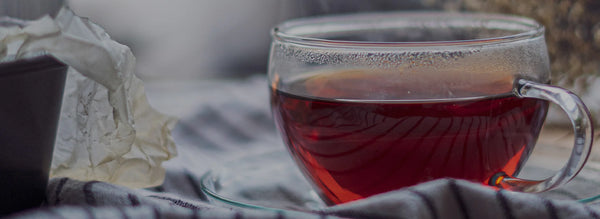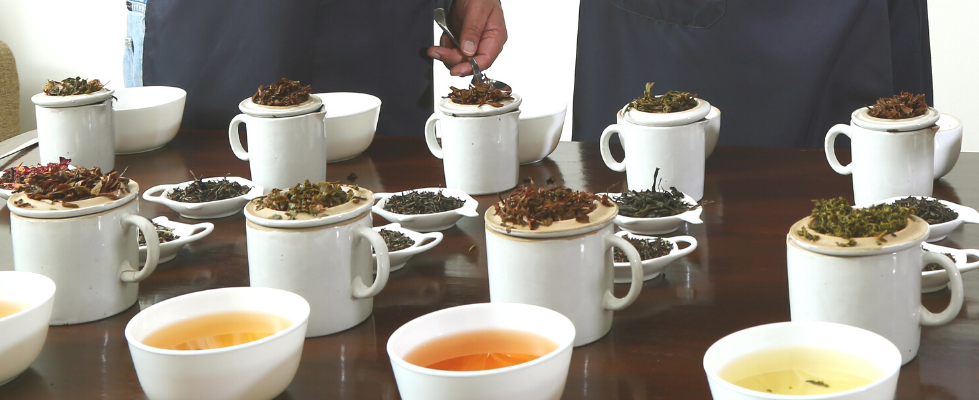A Complete Guide to Tea Tasting
Tea Tasting is similar to wine tasting, it uses four basic steps, visual, smell, taste and touch. A trained tea taster can tell you a lot about the tea by examining the dry leaves. You can take some tea in your hand, press the leaves gently, fresh tea will spring back, old tea is likely to crumble.
Tea Tasting is a process by which a trained taster accesses the quality of a particular tea. Tea is manufactured across the world, a taster needs to consider topography, climatic conditions, manufacturing process and evaluate the different clones of Camellia sinesis. All teas are made from one plant ‘Camellia sinesis’ be is white tea, oolong tea, black tea, green tea, the manufacturing process of each tea is different in terms of flavour and taste. A trained taster needs to ascertain the quality prior to sale or if they are considering blending it with other tea.
A tea taster after tasting describes the tea and values the tea. He describes the liquor which is based on taste, and includes aroma. During peak tea manufacturing season, a taster deals with several hundreds of samples a day. His evaluation is based on knowledge and experience which he develops over the years.

How is tea tasting done, what all is required?
The process is that each sample of tea is weighed and put into a cup, generally white cups or clear cups are used to see the colour.
Preparing for tea tasting
- Take 2 grams of tea
- Put it in a white cup
- Pour boiling water for black tea, for green tea water boiled at <90 deg C for under 3 mins
- Let the tea brew for 3 – 5 minutes
- Pour it into a bowl
- Use a big spoon to taste
Steps for evaluating the tea during tea tasting
Step 1: It starts with the analysis of the infused leaves, smaller leaves will show more body than larger twisted leaves. After that take in the aroma and
Step 2: Smell the aroma of the tea and examine the infused leaves for colour and evenness.
Step 3: The taster then checks the leaf colour, size and shape of the tea and specific language which has been created by the tea industry is used to explain the overall quality.
The role of your tongue in tea tasting
A tea taster uses a large spoon to take tea from the bowl and then noisily slurps on it in the mouth. The process of slurping ensures that oxygen is passed over the taste buds / receptors on the tongue, this gives an even taste of the tea.
Our tongue is capable of tasting four basic kids of taste: bitterness, sweet, sour and saltiness. The tip of the tongue is used to taste sweetness, the back of the tongue is used to taste bitterness. Saltiness is also tasted at the tip and also at the sides of the front of the tongue, sourness from the back edges. When the liquor is swirled in the mouth, a taster looks for thickness and body of the liquor. A taster refers to ‘infused leaf’ as the wet leaf after the liquor is drained out, ‘Infusion’ refers to the liquor.
Sourness is experienced at the back edges. A stringency or pungency is a sensation, not a taste that is felt on the gums and part of the cheek. When the liquor is swirled round the mouth, the thickness, body or viscosity is felt and judged. For tasters, "infused" leaf refers to the wet leaf left over after the liquor is drained out; "infusion" refers to the liquor. The flavour characteristics and leaf colour, size and shape are graded using a specific language created by the tea industry to explain the overall quality.
Skills required for becoming a Tea Taster
Tea tasting is a skill and it can be performed by people who have a good palate and an active olfactory nerve. Apart from tasting and describing the tea, the ability to value the tea comes with experience and knowledge acquired on the job.
Decoding and understanding tea terminology used by online tea stores
When you are browsing the internet to buy tea, you come across a number of websites and online tea stores which have a whole lot of tea jargon with fancy words describing their products. So what are these terms or nomenclatures that are used by companies?
Expert Tea Taster, Tea Planter, tea manufacturers evaluate tea on four basic parameters: Liquor, Infused Leaf appearance, smell and appearance of dry leaf. So what exactly are they looking for?
Liquor – What does the liquor taste like?
Infused leaf – What is the appearance of the infused leaf and how does it smell?
Dry leaf – What is the appearance of the dry leaf?
Here is a list of terms which are used extensively during tea tasting.
Terms used for evaluating Liquor
Autumnal: A seasonal term applied to teas grown during the period, possessing flavour
Bakey: Unpleasant taste usually caused by very high temperatures and driving out too much moisture during firing
Body: A liquor possessing fullness and strength
Bright: As opposed to dull
Brisk: A live taste in the liquor, as opposed to be flat or soft
Burn: Generally applicable to Darjeeling Tea
Burnt: Tea which has been subjected to extreme high temperature during firing. Undesirable
Character: A most desirable quality which also permits recognition of the origin of growth of the tea
Coarse: Opposed to brisk, Generally descriptive of secondary CTC dusts
Colour: Denoting depth of the colour. Different growth / grades possess varying hues of colour
Contamination: Taint, A taste foreign to tea, caused by contact or proximity to odours substances eg. Oil, spices, chemical, bacteria etc.
Creamy: Precipitate obtained on cooling of tea. A bright cream indicates a good tea.
Dry: Slightly bakey or high fired
Dull: A liquor that is neither clear or bright/brisk. Caused by several factors such as bacterial contamination, faulty firing of excessive moisture content
Flat: A liquor possessing strength and body
Fully Fired: Slightly over-fired. The term cautions for ensuring that future manufacture doe not become high fired.
Harsh: Usually the result of immature tea or tea made from coarse leaf. Inefficient fermenting/drying may cause harshness.
High-fired: A tea which received too much fire
Mouldy: Suspension of mould
Old: Having lost most original attributes through age
Pungent: Extremely brisk, most desirable
Quality: Essential characteristics of a good tea
Smokey: Self explanatory
Soft: Liquor characters reverse of brisk, lacking life
Stewy: Where fermentation has not been arrested in the dryer
Strength/Strong: Substance in liquor body
Sweaty : Undesirable taste due to storage in heaps on floor for long durations
Thin: Lacking in body – often due to under withering or inadequate fermentation
Wild: Liquor character found in end of season teas. Undesirable
Terms used for evaluating infused leaf
Bright : Alive, as opposed to a dull looking infusion
Coppery: Colour of infused leaf, usually denoting a good quality tea. Reference particularly to CTC
Dull: Opposed to bright.
Even: The term is usually combines with ‘bright’ or ‘coppery’, no irregularity in colour
Mixed / Uneven : Infused leaf which has more than one colour
Green: Generally undesirable. Typical of first flush
Terms used for evaluating dry leaf
Acceptable: A tea which incspite of a fault can be taken to the market
Attractive: Well made, uniform in colour and size
Black: Describing colour of dry leaf a desirable characteristic for orthodox teas
Blackish: Used for CTC tea. Desirable for internal market
Bloom: A live, rather than dull looking tea. Bloom is often lost to cutting / over handling during sorting
Bold: Pieces leaf that are too big for a grade
Brown: Undesirable leaf colour both for Orthodox and CTC
Case- hardened: Hardening of the outside case of the leaf, caused by too quick and hard fire. Such teas seldom keep well
Chesty: Taint caused by unseasoned chest panels
Chunky: Usually applied to large sized tip. Desirable
Clean: Free of stalk/fibre
Cut: Orthodox leaf cut in breaker rather than sized in the roller
Even: Grade consisting of roughly equal size pieces
Fiber: Shreds of stalks in CTC grade – indicating bad plucking
Flaky: A flat, open leaf as opposed to a well twisted leaf. Usually the result of poor withering / rolling
Golden Tip: Highly desirable feature in Orthodox teas, representative of pubescent buds
Grape nutty: CTC teas not having completely smooth appearance
Grainy: Hard cut CTC leaf, desirable for internal market
Grey: Most undesirable colour of dry leaf caused by faulty handling, over sorting
Gritty: CTC leaf that feels jagged to the touch
Green – leaf: The result of insufficient withering or under fermentation in CTC teas
Irregular: Describing size of a grade, implying it is too large for market requirements
Large: Describing size of a grade, implying its too large for market requirements
Make: A tea having ‘make’ has been carefully manufactured
Milled: Tea leaf put through a cutter and ground
Mixed: Denotes presence of other grades in a particular grade. Undesirable
Neat: Well made teas of even appearance
Pale tip: Denoting colour, in contrast to ‘golden’ generally less valuable
Ragged: Rough and uneven leaf
Reddish: Usually end of season leaf colour
Shotty: Well made and rolled, particularly of Orthodox BPS
Small: A grade of lesser size than is normal for it
Stalky: Indicating undue presence of stalk. The result of coarse plucking
Stylish: Neat and of superior leaf appearance
Twist: Well rolled, particular reference to whole leaf
Uneven: a grade composed of uneven pieces of leaf
Well-made: Uniform in colour, size and texture
Whiskery: Long fibre, Undesirable
Additional Tea Tasting Terms used to describe Darjeeling Tea
Aroma: It is the aroma of the tea liquor also referred as nose or fragrance. A complex aroma is described as a bouquet.
Astringency: No bitterness, a clean refreshing quality. It also has a mouth drying effect on the tongue. Astringency is a reaction between polyphenols (tannins) and the protein in saliva.
Body: Usually used to describe the tea its fullness and strength. Usually described as light, medium of full. Also used to describe CTC tea – lively with bright / red liquor.
Bright: Describes a good quality fresh tea, also used to describe a cup of CTC liquor. A tea which is clean and refreshes the palate.
Brisk: Usually used to describe the a fresh lively taste in the liquor. It is fresh on the palate and has no additional taints.
Clean: explains that the liquor is pure and is absent of any off-tastes.
Character: Describes tea from a particular region, origin and type of tea.
Finish: The taste left on your tongue after you have swallowed the tea
Malty: The main characteristic of good Assam Black tea.
Flowery: Described by the nose, usually associated with Darjeeling and speciality teas
Full: A strong cup of tea, with good colour, strength and no bitterness
Muscatel: A flavour found in muscat grapes, also found in good second flush Darjeeling tea
Smooth: Fine round-bodied tea
Soft: Lacks any life, best described as the opposite of briskness
Vegetal: A term used to describe green tea, the grassy feel














7 Comments
Explore the delightful world of tea tasting! Check out Teacupsfull’s blog for tips, techniques, and new flavors.
لذلك هناك متذوقون عرب قد اضافو لنكهات الشاي تميّزا كاللون والنكهة الحادّة بطريقة الإعداد واضافو نكهة الشاي المدخن نتيجة طريقتهم باعداده بالخارج تحت حطب بري مميز بنكته المتداخلة مع الشاي. تحياتي وائل الدغفق صاحب متحف الشاي بالخبر بالمملكة
العربية السعودية
I AM ALSO A TEA TASTER
AND ABOVE DETAILS ABOUT TEA & TEA TASTING IS PERFECT FOR THE TEA LOVERS.
Very intresting